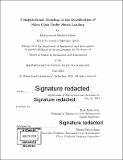Computational modeling of the densification of silica glass under shock loading
Author(s)
Islam, Mohammad Shafaet
DownloadFull printable version (14.97Mb)
Other Contributors
Massachusetts Institute of Technology. Department of Aeronautics and Astronautics.
Advisor
Raúl Radovitzky.
Terms of use
Metadata
Show full item recordAbstract
Under extremely high pressures (greater than 10 GPa), glass undergoes a severe permanent reduction in volume. The permanent densification of glass serves as a mechanism for the material to absorb large amounts of energy under pressures potentially achievable during ballistic loading. This ability has recently garnered interest in glass as a candidate material for ballistic protection. The development of such glass-based protection systems can be aided by simulation tools. However, this requires an accurate constitutive model capturing material response under high pressure and shear. In this work, we develop three constitutive models for glass of varying complexity which account for its response to loading, including during densification. Our most comprehensive model combines an equation of state for glass with a plasticity model whose flow rule permits permanent volumetric reduction. The model shows a satisfactory match to experimental pressure-density data for a wide range of pressures, including those within the densification regime. To verify the model, we simulate shock conditions in an idealized piston using finite element simulation, and find that the Rankine-Hugoniot jump conditions are satisfied. Lastly, we use the model to aid the design of high pressure experiments of glass capable of causing densification. We perform finite element simulation of two experimental geometries. The first geometry uses laser induced surface acoustic waves to generate high pressures, while the second design uses shock waves that travel through the entire body of the sample. The first design illustrates a competition between densification and fracture. In particular, highly tensile stresses causing fracture in experimental samples mitigate high compressive stresses necessary for transformation. The second design is a converging shock configuration which avoids this issue and therefore can be used to evaluate the mechanical response of glass at high pressures. The computational framework presented here can be used to design better experiments for glass testing as well as measure the ballistic protection performance of glass under extreme loads.
Description
Thesis: S.M., Massachusetts Institute of Technology, Department of Aeronautics and Astronautics, 2018. Cataloged from PDF version of thesis. Includes bibliographical references (pages 121-125).
Date issued
2018Department
Massachusetts Institute of Technology. Department of Aeronautics and AstronauticsPublisher
Massachusetts Institute of Technology
Keywords
Aeronautics and Astronautics.